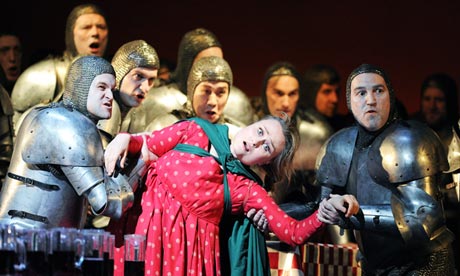
To paraphrase Madonna, when the nuns in Robert le diable get down on their knees, it is not to pray. Religious ecstasy has many varieties. In Meyerbeer's French gothic extravaganza the sisters are dead anyway, summoned from their cloistered graves by the devil to engage in the lust and debauchery they always longed for. Straightening their see-through shrouds, they dance a full-length ballet with extended thrusting and grunting – astride the tenor hero, each other or the open tombs they have just abandoned. It is no better and no worse than you might imagine. At times, silent chortling was inevitable.
The Royal Opera, staging the work for the first time since 1890 – the questions why and why not spring to the lips simultaneously – called on Laurent Pelly to direct, with ingenious choreography by Lionel Hoche and conductor Daniel Oren tight-reined in the pit. There are many pits here, from moral to infernal, but the orchestra climbed out of theirs to reach a celestial peak of excellence. The score, at once predictable in the galloping rhythms and eddying climaxes and inventively unexpected in the use of solo instruments, is dazzlingly effective and wholly unmemorable.
Vocally, several spectacular arias, hazardous unaccompanied passages and bold, effective choruses remind us why Meyerbeer was a vital figure in the development of French grand opera. The five-act Robert le diable, premiered in Paris in 1831, was a hit until 20th-century turpitude deemed it bad taste – would you credit it? – and the work fell out of favour. You can see exactly where Gilbert and Sullivan found some of their ping-pong-style solo versus chorus effect ("I did." "You did?" "I did?" "He did." "We did. We did. We did"). It's no surprise to find WS Gilbert was one of many who lampooned Robert, producing a parody called The Nun, The Dun, and the Son of a Gun.
Jinxed by soprano comings and goings, this production has not had an easy birth. The latest was the sudden advent, just days ago, of Patrizia Ciofi as the saintly Princess Isabelle, replacing Jennifer Rowley who was deemed unsuitable. As usual, many who have never tried to cast an opera rushed to explain how incompetent and brainless the Royal Opera House had been in trying out someone in the role who had never sung it before. Since the work is so rarely performed almost no one ever has. On this logic the word "debut" would become defunct. Fortunately the bewitching Ciofi, doll-like and almost mechanically surreal in physique and voice, was a perfect fit. Her first aria, starting low and reaching stratospheric in a couple of bars, could certainly take on a yodelling quality in the wrong hands, and we were saved from that.
Given the technical difficulties of the piece, not to mention all the extenuating circumstances, the entire cast impressed: John Relyea's satanically dark Bertram, Jean-François Borras's lithe, eager Raimbaut and Bryan Hymel in the taxing title role were supported by a sturdy, enthusiastic chorus. Hymel especially deserves praise for stamina, succeeding in a large proportion of his outrageously numerous top notes. His permanently surprised kohl eyebrows and manic appearance were par for the course. Marina Poplavskaya, another who came and went but then came back again, sang the Maid Marian role of Alice. Despite some dryness in the upper range she held on gamely to the a cappella passages and, with long plaits and green cape, looked as if she had stepped straight from the pages of an illuminated miniature.
You might accuse Pelly of not taking the work seriously. So remote is it from modern sensibilities and aesthetics, it's hard to see how he, or anyone, could. With sumptuous costumes designed by Pelly himself, it looked stylish, and for a work that lasts four and a half hours and is not Wagner that is a mercy. The medieval setting – no point in elaborating on the plot beyond saying that the knight Robert finds he is the son of Bertram whom we recognise as the devil – inspired colourful pop-up book imagery from set designer Chantal Thomas. Eclectic is a polite description: all the visual world was here, from Les très riches heures to Memling, Gustave Doré, Fuseli and, for Isabelle's plasticated boudoir, Polly Pocket. So Bosch to tosh, fascinating and ridiculous and something one never need see again.
Attention, as it should be anyway when thinking about music, was on composers this week, for reasons both of celebration and mourning. Two influential figures died on Wednesday, Jonathan Harvey at 73 and the jazz giant Dave Brubeck at 91. Harvey, whose music always reached out towards the spiritual and visionary, wedded electronics to traditional instruments in a consistently exciting way. He was among the composers shortlisted in the 10th British Academy of Songwriters, Composers and Authors awards, announced at Goldsmiths' Hall on Monday and broadcast on Radio 3 today. With winners including Colin Matthews, Harrison Birtwistle, Thomas Adès, Jocelyn Pook, Christine Tobin and Emily Howard, British musical life could scarcely be more diverse.
Two days later the London Symphony Orchestra and a phalanx of young musicians gave the world premiere of Peter Maxwell Davies's Fanfare: Her Majesty's Welcome, and welcome she was too. Moments after, Her Majesty herself arrived to award her own Queen's Medal for Music not to an individual but to the entire National Youth Orchestra, a lucky handful of whom joined the LSO in Elgar's Enigma Variations conducted by former NYOist Robin Ticciati. In the past decade the reinvigorated organisation, founded in 1948 for talented 13- to 19-year-olds, has commissioned several new works. One, Anna Meredith's HandsFree, in which players abandon their instruments and clap, has already become a cult classic. It's a far cry from nympho nuns. The wonder is, richly against the odds, that there is room in our cultural landscape for both.

